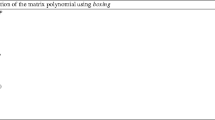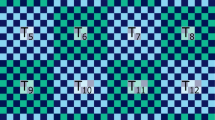Abstract
Auto-tuning techniques have been used in the design of routines in recent years. The goal is to develop routines which automatically adapt to the conditions of the computational system in such a way that efficient executions are obtained independently of the end-user experience. This paper aims to explore programming routines that can be automatically adapted to the computational system conditions, making possible to use auto-tuning to represent landform attributes on multicores and multi-GPU systems using high- performance computing techniques for efficient solution of two-dimensional polynomial regression models that allow large problem instances to be addressed.


Similar content being viewed by others
References
Alberti P, Alonso P, Vidal A, Cuenca J, Giménez D (2004) Designing polylibraries to speed up parallel computations. Int J High Perform Comput Appl 1(1/2/3):75–84
Frigo M, Johnson S (1998) FFTW: an adaptive software architecture for the FFT. Proc IEEE Int Conf Acoust Speech Signal Process 3:1381–1384
Garland M (2010) Parallel computing with CUDA. In: IPDPS, pp 10–26
Jerez S, Montávez JP, Giménez D (2009) Optimizing the execution of a parallel meteorology simulation code. In: IPDPS. IEEE Computer Society, Los Alamitos, CA, USA
Nogueira L, Abrantes RP, Leal B (2008) A methodology of distributed processing using a mathematical model for landform attributes representation. In: Proceeding of the IADIS International Conference on applied computing, pp 17–21
Nogueira L, Abrantes RP, Leal B, Goulart C (2008) A model of landform attributes representation for application in distributed systems. In: Proceeding of the IADIS International Conference on applied computing
Rawlings JO, Pantula SG, Dickey DA (1998) Applied regression analysis: a research tool. Springer, London
Rufino I, Galvao C, Rego J, Albuquerque J (2009) Water resources and urban planning: the case of a coastal area in Brazil. J Urban Environ Eng 3:32–42
Song F, Tomov S, Dongarra J (2011) Efficient support for matrix computations on heterogeneous multicore and multi-GPU architectures. Tech Rep 250, LAPACK working note
Whaley C, Petitet A, Dongarra JJ (2000) Automated empirical optimization of software and the ATLAS project. Parallel Comput 27:21–31
Acknowledgments
This work has been partially supported by European Union ERDF and Spanish Government through TEC2012-38142-C04 project.
Author information
Authors and Affiliations
Corresponding author
Rights and permissions
About this article
Cite this article
Boratto, M., Alonso, P., Gimenéz, D. et al. Automatic routine tuning to represent landform attributes on multicore and multi-GPU systems. J Supercomput 70, 733–745 (2014). https://doi.org/10.1007/s11227-014-1191-0
Published:
Issue Date:
DOI: https://doi.org/10.1007/s11227-014-1191-0




